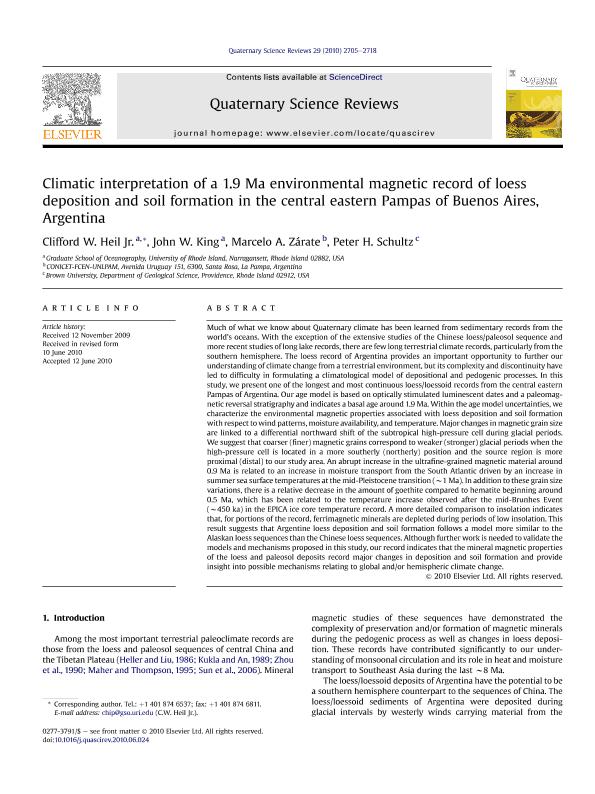Mostrar el registro sencillo del ítem
dc.contributor.author
Heil, Clifford W.
dc.contributor.author
King, John W.
dc.contributor.author
Zárate, Marcelo Arístides

dc.contributor.author
Schultz, Peter H.
dc.date.available
2019-08-14T22:31:39Z
dc.date.issued
2010-09
dc.identifier.citation
Heil, Clifford W.; King, John W.; Zárate, Marcelo Arístides; Schultz, Peter H.; Climatic interpretation of a 1.9 Ma environmental magnetic record of loess deposition and soil formation in the central eastern Pampas of Buenos Aires, Argentina; Pergamon-Elsevier Science Ltd; Quaternary Science Reviews; 29; 19-20; 9-2010; 2705-2718
dc.identifier.issn
0277-3791
dc.identifier.uri
http://hdl.handle.net/11336/81635
dc.description.abstract
Much of what we know about Quaternary climate has been learned from sedimentary records from the world's oceans. With the exception of the extensive studies of the Chinese loess/paleosol sequence and more recent studies of long lake records, there are few long terrestrial climate records, particularly from the southern hemisphere. The loess record of Argentina provides an important opportunity to further our understanding of climate change from a terrestrial environment, but its complexity and discontinuity have led to difficulty in formulating a climatological model of depositional and pedogenic processes. In this study, we present one of the longest and most continuous loess/loessoid records from the central eastern Pampas of Argentina. Our age model is based on optically stimulated luminescent dates and a paleomagnetic reversal stratigraphy and indicates a basal age around 1.9 Ma. Within the age model uncertainties, we characterize the environmental magnetic properties associated with loess deposition and soil formation with respect to wind patterns, moisture availability, and temperature. Major changes in magnetic grain size are linked to a differential northward shift of the subtropical high-pressure cell during glacial periods. We suggest that coarser (finer) magnetic grains correspond to weaker (stronger) glacial periods when the high-pressure cell is located in a more southerly (northerly) position and the source region is more proximal (distal) to our study area. An abrupt increase in the ultrafine-grained magnetic material around 0.9 Ma is related to an increase in moisture transport from the South Atlantic driven by an increase in summer sea surface temperatures at the mid-Pleistocene transition (∼1 Ma). In addition to these grain size variations, there is a relative decrease in the amount of goethite compared to hematite beginning around 0.5 Ma, which has been related to the temperature increase observed after the mid-Brunhes Event (∼450 ka) in the EPICA ice core temperature record. A more detailed comparison to insolation indicates that, for portions of the record, ferrimagnetic minerals are depleted during periods of low insolation. This result suggests that Argentine loess deposition and soil formation follows a model more similar to the Alaskan loess sequences than the Chinese loess sequences. Although further work is needed to validate the models and mechanisms proposed in this study, our record indicates that the mineral magnetic properties of the loess and paleosol deposits record major changes in deposition and soil formation and provide insight into possible mechanisms relating to global and/or hemispheric climate change.
dc.format
application/pdf
dc.language.iso
eng
dc.publisher
Pergamon-Elsevier Science Ltd

dc.rights
info:eu-repo/semantics/openAccess
dc.rights.uri
https://creativecommons.org/licenses/by-nc-sa/2.5/ar/
dc.subject
Magnetic Susceptibility
dc.subject
Loess
dc.subject
Paleosols
dc.subject
Pampas
dc.subject.classification
Geología

dc.subject.classification
Ciencias de la Tierra y relacionadas con el Medio Ambiente

dc.subject.classification
CIENCIAS NATURALES Y EXACTAS

dc.title
Climatic interpretation of a 1.9 Ma environmental magnetic record of loess deposition and soil formation in the central eastern Pampas of Buenos Aires, Argentina
dc.type
info:eu-repo/semantics/article
dc.type
info:ar-repo/semantics/artículo
dc.type
info:eu-repo/semantics/publishedVersion
dc.date.updated
2019-08-13T19:13:37Z
dc.journal.volume
29
dc.journal.number
19-20
dc.journal.pagination
2705-2718
dc.journal.pais
Países Bajos

dc.journal.ciudad
Amsterdam
dc.description.fil
Fil: Heil, Clifford W.. University of Rhode Island; Estados Unidos
dc.description.fil
Fil: King, John W.. University of Rhode Island; Estados Unidos
dc.description.fil
Fil: Zárate, Marcelo Arístides. Consejo Nacional de Investigaciones Científicas y Técnicas. Instituto de Ciencias de la Tierra y Ambientales de La Pampa. Universidad Nacional de La Pampa. Facultad de Ciencias Exactas y Naturales. Instituto de Ciencias de la Tierra y Ambientales de La Pampa; Argentina
dc.description.fil
Fil: Schultz, Peter H.. Brown University; Estados Unidos
dc.journal.title
Quaternary Science Reviews

dc.relation.alternativeid
info:eu-repo/semantics/altIdentifier/url/https://www.sciencedirect.com/science/article/pii/S0277379110002180
dc.relation.alternativeid
info:eu-repo/semantics/altIdentifier/doi/https://doi.org/10.1016/j.quascirev.2010.06.024
Archivos asociados
